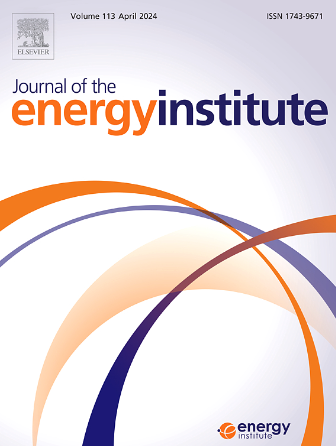Formation characteristics of NO during ammonia-coupled volatile/char combustion processes: Influence mechanism of iron in coal
IF 5.6
2区 工程技术
Q2 ENERGY & FUELS
引用次数: 0
Abstract
The inherent mineral Fe in coal significantly affects the NO generation NO during coal combustion, but its mechanism for NO generation during ammonia-coal co-combustion is not yet clear. In this study, a coupled combustion system and a separated combustion system were constructed to investigate NO generation characteristics during ammonia/raw coal, ammonia/demineralized coal, and ammonia/impregnated-Fe co-firing. The results showed that introducing Fe didn't change the NO generation characteristics. The characteristics of NO generation were similar in the volatile combustion and coal char combustion stages. In the volatile combustion stage, the amount of NO increased with the increase in temperature and ammonia mixing ratio. In the coal char combustion stage, the reducing effects of unburned ammonia and coal char were enhanced at high temperatures, which led to a decrease in NO at high temperatures. Compared with coupled combustion, separation combustion can significantly reduced NO emissions and inhibited the conversion of fuel-N to NO. Under separation combustion, mineral Fe significantly inhibited the conversion of fuel-N to NO in the volatile combustion stage and the coal char combustion stage, among which 1200–1400 °C was the best temperature range for mineral Fe to inhibit the conversion of fuel-N to NO under separation combustion.
氨耦合挥发/炭燃烧过程中NO的生成特征:煤中铁的影响机理
煤中固有矿物铁显著影响煤燃烧过程中NO的生成,但其在氨煤共燃烧过程中NO生成的机理尚不清楚。本研究通过构建耦合燃烧系统和分离燃烧系统,研究氨/原煤、氨/脱矿煤、氨/浸渍铁共烧过程中NO的生成特性。结果表明,Fe的加入没有改变NO的生成特性。挥发性燃烧和煤焦燃烧阶段NO的生成特征相似。在挥发性燃烧阶段,NO的数量随着温度和氨混合比的增加而增加。在煤焦燃烧阶段,未燃氨和煤焦在高温下的还原作用增强,导致高温下NO含量降低。与耦合燃烧相比,分离燃烧能显著降低NO排放,抑制燃料n向NO的转化。分离燃烧条件下,矿物Fe在挥发燃烧阶段和煤焦燃烧阶段均显著抑制燃料n向NO的转化,其中矿物Fe在分离燃烧条件下抑制燃料n向NO转化的最佳温度范围为1200 ~ 1400℃。
本文章由计算机程序翻译,如有差异,请以英文原文为准。
求助全文
约1分钟内获得全文
求助全文
来源期刊

Journal of The Energy Institute
工程技术-能源与燃料
CiteScore
10.60
自引率
5.30%
发文量
166
审稿时长
16 days
期刊介绍:
The Journal of the Energy Institute provides peer reviewed coverage of original high quality research on energy, engineering and technology.The coverage is broad and the main areas of interest include:
Combustion engineering and associated technologies; process heating; power generation; engines and propulsion; emissions and environmental pollution control; clean coal technologies; carbon abatement technologies
Emissions and environmental pollution control; safety and hazards;
Clean coal technologies; carbon abatement technologies, including carbon capture and storage, CCS;
Petroleum engineering and fuel quality, including storage and transport
Alternative energy sources; biomass utilisation and biomass conversion technologies; energy from waste, incineration and recycling
Energy conversion, energy recovery and energy efficiency; space heating, fuel cells, heat pumps and cooling systems
Energy storage
The journal''s coverage reflects changes in energy technology that result from the transition to more efficient energy production and end use together with reduced carbon emission.
 求助内容:
求助内容: 应助结果提醒方式:
应助结果提醒方式:


